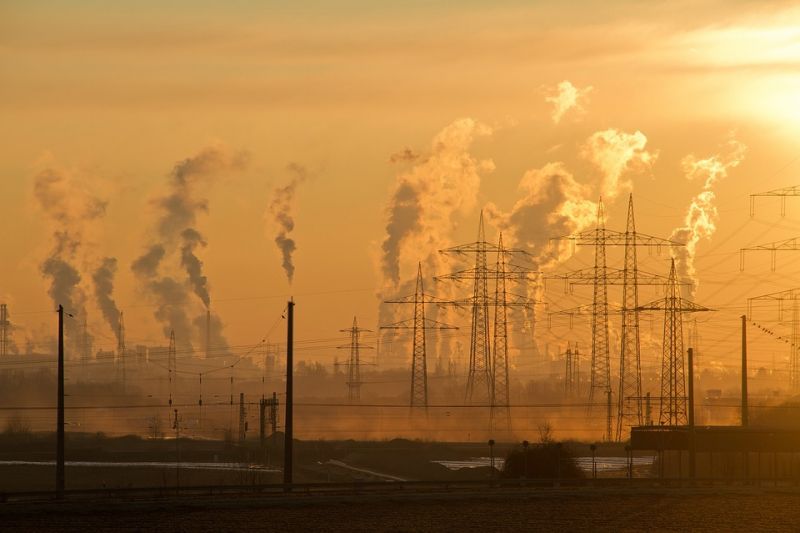Coal-Fired Power Plants Are Polluting Groundwater (Fluence Study)
Published on by Water Network Research, Official research team of The Water Network in Case Studies
Environmental groups are pushing for tighter regulation and enforcement of EPA rules.

Representative image source: Pixabay, labeled for reuse
A new study shows that of the 265 coal-burning power plants it studied in the United States, 241 have dangerous levels of toxic metals in the groundwater around them, based on Environmental Protection Agency (EPA) standards. The figure, which comes to 91% of the plants, was derived only from plants that must monitor the groundwater near their coal ash dumps. Coal ash is a byproduct of coal combustion stored on-site by power plants. The study was sponsored by a team of environmental groups spearheaded by the Environmental Integrity Project and Earthjustice. Lisa Evans, senior counsel for Earthjustice said:
"Using industry’s own data, our report proves that coal plants are poisoning groundwater nearly everywhere they operate."
High Levels of Contaminants
For the study, data was gathered from 4,600 monitoring wells near coal ash dumps at approximately two-thirds of U.S. coal power plants.
According to 2018 data reported by power companies, the 10 most contaminated sites are in:
- Texas : A site south of San Antonio was contaminated with 12 or more pollutants, including cadmium, as well as lithium at a concentration more than 100 times above a safe level.
- North Carolina : Near Charlotte, thyroid-damaging cobalt and eight other contaminants are infiltrating groundwater at more than 500 times safe levels.
- Wyoming: Lithium and selenium levels in groundwater have been observed at 100 times safe levels.
- Wyoming : In southwest Wyoming, groundwater levels of lithium and selenium have been detected at 100 times safe levels, and arsenic has been detected at five times safe levels.
- Pennsylvania : Northwest of Pittsburgh, arsenic in groundwater has been detected at levels 372 times higher than safe for drinking.
- Tennessee : Southwest of Memphis, close to the Mississippi River, arsenic leaks into groundwater at 350 times safe levels, and lead infiltrates at four times safe levels. A direct connection has been discovered between the contaminated aquifer and the Memphis aquifer, threatening drinking water for thousands.
- Maryland : Southeast of Washington, D.C., unsafe levels of eight or more pollutants have been measured, including lithium at more than 200 times the safe level, and kidney- and liver-damaging molybdenum at more than 100 times safe levels. The contaminated groundwater is also polluting local surface water.
- Utah : To the south of Salt Lake City, groundwater has been contaminated with lithium at 228 times the safe limit, and cobalt at 26 times the safe limit.
- Mississippi : To the north of Biloxi, groundwater has been contaminated with lithium at 193 times the safe level, molybdenum at 171 times the safe level, and arsenic at three times the safe level.
- Kentucky : Northeast of Louisville, lithium has been detected in the groundwater at 154 times the safe level, and radium has been detected at 31 times the safe level.
A breakdown of the data also showed:
- 52% percent of the plants had dangerous levels of the carcinogenic metalloid arsenic in adjacent groundwater.
- 60% of the plants had dangerous levels of the neurotoxin lithium in adjacent groundwater.
Regulation
Monitoring began under Obama administration regulations, but local testing of drinking water is not required. Regulations have relaxed for some plants, and cleanup of some ponds has been pushed back to the end of 2020. Environmental groups say it is time for tighter regulation and enforcement, but the EPA has not commented yet, pending review of the report.
Dealing With Contaminated Groundwater
Technologies available for arsenic and metal removal include coagulation filtration, oxidation filtration, adsorption with granular iron hydroxide media, ion exchange, membrane separation, and VSN-33 media. Choosing the best technology for removal of metals involves the many variables of the source water, requiring a treatment company with a deep reservoir of experience. Contact Fluence to learn about our sustainable solutions for heavy metal removal, or to discuss your next project with our experts.
Reference :
Source: Fluence Corporation
Media
Taxonomy
- Public Health
- Metals
- Heavy Metal Removal
- Industrial Wastewater Treatment
- Industrial Water Treatment
- Industrial Water Managment
- Toxins
- Groundwater
- Environment
- Contaminant Movement Mapping
- Groundwater Assessment
- Groundwater Pollution
- Groundwater Mapping
- Metals
- Heavy metals
- Ecotoxicology
- Clean Coal
- Power Generation
- Power Plants
- Power Distribution
- Power Transmission
- Toxicology
- Spill Containment
3 Comments
-
I think it's a matter of environmental technology. Coal ash can be used for the material of cement. SOx canbe eliminated by desulpherization unit. The issue I see is coal mining procedure but waste water from it can be treated with the W.W. tevhnology nowadays.
-
Possible...can you provide specific location and monitoring data, if any.
1 Comment reply
-
Hi, Prakash Gupte. It would be best to contact Fluence directly for such information. You can try it via a contact form on their website or reaching out to the company members here on the network (see the members list on Fluence's company page https://thewaternetwork.com/organization-c6k/fluence-corporation-w4E89dLalMYXqnmBY9a_iA/home). If you provide your email address and context of your interest we will forward your inquiry to the appropriate person.
-
-
Apart from ground water contamination, Seepage and spillage from ash-water bunds are causing a major problems of river pollution in many Thermal (coal fired) plants in India. The river TDS has increased many times and the source water has become unfit for treatment by surface water treatment plants of communities in the vicinity.